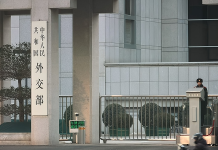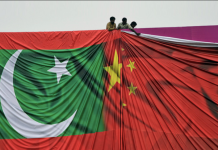China’s economy experienced a strong rebound in 2021, despite sporadic COVID-19 cases at home and external uncertainty. Its GDP expanded 8.1 percent year on year to 114.37 trillion yuan ($18 trillion) last year, well above the annual target of more than 6 percent, according to the National Bureau of Statistics (NBS) on January 17. Per-capita GDP reached around $12,500, exceeding the global average.
With steady economic recovery and pandemic control in 2021, China was among the fastest growing major economies. It is estimated to account for more than 18 percent of the world economy and contribute some 25 percent to global GDP growth.
The Chinese economy grew 18.3 percent, 7.9 percent, 4.9 percent and 4 percent in the four quarters of 2021, respectively, showing mounting downward pressure. However, the average month-on-month growth in the fourth quarter reached 1.6 percent, as the government’s growth-boosting policies paid off, Wen Bin, chief analyst at China Minsheng Bank, told Beijing Review.
Last year, final consumption contributed 65.4 percent to GDP expansion, and net exports 20.9 percent. NBS head Ning Jizhe told a press conference that expansion of production boosted the improvement of people’s income and drove up household spending. Meanwhile, growing domestic demand and the nation’s complete industrial system were essential to import and export growth. Domestic demand contributed 79.1 percent to economic growth, up 4.4 percent from 2020, according to Ning.
Ning stressed that the recovery of domestic and external demand will further back up economic growth this year. The boom of the hi-tech and service sectors, low-carbon transformation, opening-up efforts and improvement of income distribution will add momentum to high-quality economic development.
Benefits of openness
Foreign trade expanded 21.4 percent year on year to 39.1 trillion yuan ($6.1 trillion) in 2021, with exports up 21.2 percent and imports up 21.5 percent, according to the General Administration of Customs of China (GACC). It was the first time the volume crossed the $6-trillion mark.
While the pandemic continued to impact global supply chains, exports of medical materials and medicines more than doubled last year, and products related to the stay-at-home economy, such as laptops and home appliances, saw a 13.2-percent year-on-year increase.
“China has effectively controlled the spread of COVID-19. As its supply and industrial chains recovered, Chinese enterprises have received more overseas orders,” Xu Hongcai, Deputy Director of the Economic Policy Commission under the China Association of Policy Science, told Beijing Review.
The Regional Comprehensive Economic Partnership (RCEP) agreement, signed by 15 Asia-Pacific countries including China, took effect on January 1, creating the world’s largest trade bloc. China’s imports and exports with the other 14 RCEP members went up 18.1 percent year on year to 12.07 trillion yuan ($1.9 trillion) last year, accounting for 30.9 percent of its foreign trade volume.
The country remained a magnet for investment. Paid-in foreign direct investment (FDI) expanded 14.9 percent year on year to a record high of 1.14 trillion yuan ($181 billion). FDI inflow into the service sector increased 16.7 percent year on year to 906.49 billion yuan ($142.79 billion), the Ministry of Commerce (MOFCOM) said.
With two shortened negative lists taking effect on January 1, off-limits items for foreign investors in pilot free trade zones (FTZs) were cut to 27 from 30 and those in non-FTZ areas were reduced to 31 from 33. The automobile manufacturing sector and the service industry have been further opened up.
According to MOFCOM, foreign investment in advanced manufacturing, modern services, energy conservation, environmental protection, and the digital economy will be further encouraged.
The RCEP is expected to boost investment between China and other members, according to Zhao Jinping, a researcher with the Development Research Center of the State Council. The bloc will account for nearly 30 percent of global FDI, Zhao told a forum on January 10.
As a result of the U.S. Federal Reserve’s monetary policy tightening signal, some emerging economies have experienced financial fluctuations. Nevertheless, China’s financial system has remained stable, Xu said. China’s foreign exchange reserves stood at $3.25 trillion at the end of December 2021, up $27.8 billion month on month and hitting a six-year high, the State Administration of Foreign Exchange said.
Last December, the People’s Bank of China raised the reserve requirement ratio for foreign currency deposits from 7 percent to 9 percent. According to Wen, rapid strengthening of the yuan would cause losses to small and medium-sized export-oriented enterprises. The central bank’s move can reduce liquidity of the U.S. dollar to ease appreciation pressure on the yuan and stabilize the exchange rate between the two currencies.
Robust activity
In 2021, industrial production further resumed its growth momentum. Value-added industrial output, a major economic indicator, went up 9.6 percent year on year. Net profits of state-owned enterprises rose 29.8 percent year on year to 1.8 trillion yuan ($283.56 billion).
By the end of last year, the number of Chinese businesses exceeded 150 million, of which more than 100 million were self-employed individuals. The government provided support for small and medium-sized enterprises (SMEs) amid rising prices of production materials, mainly by reducing taxes and fees, and cutting financing costs. In the fourth quarter, small and micro enterprises benefiting from tax reduction policies accounted for 62.3 percent of the total. The Beijing Stock Exchange began trading last November, providing targeted support for innovation-driven SMEs.
New driving forces played a greater role. Last year, expenditure on research and development grew 14.2 percent year on year, 4 percentage points higher than the 2021 level. The value added of the hi-tech manufacturing industry expanded 18.2 percent year on year. The output of new-energy vehicles soared 145.6 percent over 2021.
The service industry saw its value added exceed 60 trillion yuan ($9.4 trillion), up 8.2 percent year on year. It accounted for 53.3 percent of the country’s GDP, contributing 54.9 percent to overall economic growth.
Low-carbon development was a major theme last year. The proportion of clean energy, including natural gas, hydro, nuclear and wind power, in power consumption increased 1 percentage point from the year before, with that of coal falling 0.8 percentage point. China’s energy intensity, or energy consumption per unit of GDP, declined 2.7 percent year on year.
“To boost green and low-carbon enterprises, financial institutions need to provide more support to channel funds into the sectors and up the issuance of green bonds,” Xu said. -The Daily Mail-Beijing Review News Exchange Item






